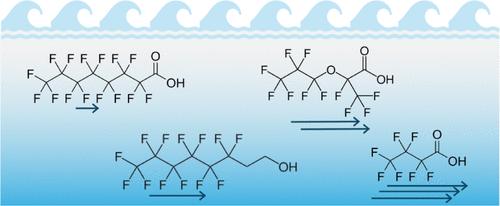Experimentally Determined Aqueous Diffusion Coefficients of PFAS Using 19F NMR Diffusion-Ordered Spectroscopy
引用次数: 0
Abstract
Per- and polyfluorinated alkyl substances (PFAS) can be found in nearly every aqueous environmental compartment, including rainwater, snow, surface waters, lakes, and oceans. Despite the global distribution of PFAS in the aquatic environment, little is known regarding their diffusion through aqueous systems. This can be limiting for passive sampling techniques, which depend on accurate diffusion coefficients to relate sampler concentrations of PFAS to system-wide concentrations. Existing methods for the measurement of aqueous diffusivity can be time-consuming, challenging, and subject to error when measuring highly fluorinated surfactants. In the present study, we employ fluorine NMR diffusion-ordered spectroscopy (19F DOSY) to experimentally determine the aqueous diffusion coefficient accurately for 47 PFAS. Aqueous diffusion was found to decrease with increasing fluorinated chain length and increase with the inclusion of ether linkages. The impacts of the ionic strength, temperature, and concentration on the aqueous diffusion of PFAS were also examined. The 19F NMR DOSY method demonstrates reasonable agreement with literature values where available. Numerous PFAS do not have published aqueous diffusion coefficients, which are reported here for the first time. This data allow passive sampling and environmental modeling methods to be greatly improved for monitoring PFAS in the aquatic environment.

使用 19F NMR 扩散有序光谱法实验测定 PFAS 的水扩散系数
全氟和多氟烷基物质(PFAS)几乎存在于所有水环境区划中,包括雨水、雪、地表水、湖泊和海洋。尽管 PFAS 在水生环境中的分布遍及全球,但人们对其在水生系统中的扩散却知之甚少。这可能会限制被动采样技术的发展,因为被动采样技术依赖于准确的扩散系数,才能将采样器中的 PFAS 浓度与整个系统的浓度联系起来。现有的水体扩散系数测量方法耗时长、难度大,而且在测量高氟表面活性剂时容易出错。在本研究中,我们采用氟核磁共振扩散有序光谱法(19F DOSY),通过实验准确测定了 47 种 PFAS 的水扩散系数。研究发现,水扩散系数会随着含氟链长的增加而降低,并随着醚键的加入而增加。此外,还研究了离子强度、温度和浓度对全氟辛烷磺酸水扩散的影响。19F NMR DOSY 方法与文献值(如有)显示出合理的一致性。许多 PFAS 没有公布水体扩散系数,在此首次报告。有了这些数据,就可以大大改进被动采样和环境建模方法,从而监测水生环境中的全氟辛烷磺酸。
本文章由计算机程序翻译,如有差异,请以英文原文为准。
求助全文
约1分钟内获得全文
求助全文

 求助内容:
求助内容: 应助结果提醒方式:
应助结果提醒方式:


